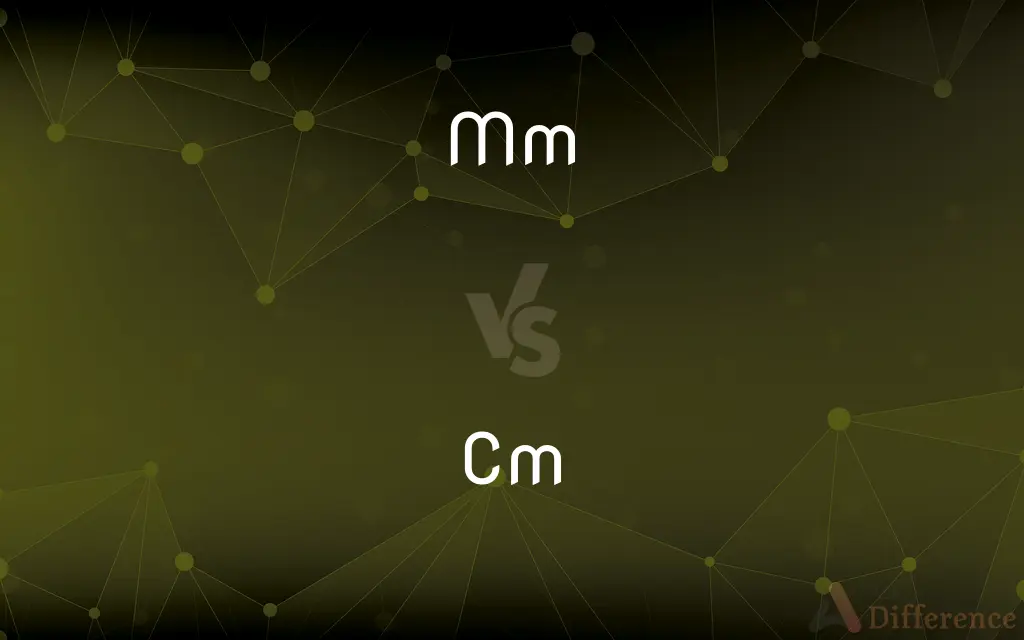MM vs. CM — What's the Difference?
By Tayyaba Rehman — Updated on October 28, 2023
MM stands for millimeters, a unit measuring 1/1,000th of a meter. CM denotes centimeters, with 1 cm equal to 1/100th of a meter.

Difference Between MM and CM
Table of Contents
ADVERTISEMENT
Key Differences
In the metric system, both MM and CM are common units of length. MM, representing millimeters, is one of the smaller units in the metric hierarchy. It is particularly useful when precision is essential, such as in engineering blueprints or detailed craftwork. CM, on the other hand, stands for centimeters. This unit is ten times larger than a millimeter and is often used for more general measurements, like noting the dimensions of everyday objects.
When dealing with scale and proportion, the distinction between MM and CM becomes crucial. A difference of a few millimeters might not sound like much, but in fields like dentistry or jewelry design, such small distinctions can be significant. In contrast, centimeters offer a broader perspective, making them more suitable for measuring things like clothing or room dimensions.
In daily life, both MM and CM have their places. MM might be the preferred unit when measuring the thickness of a credit card, while CM might be used to measure shoe size or the width of a book. Given their varying scales, it's important to choose the unit that offers the most clarity in context.
In mathematics and science, the accurate use of units like MM and CM can impact results and interpretations. For instance, when calculating volume or area, mixing up millimeters and centimeters can lead to a significant discrepancy in outcomes. Such nuances underline the importance of understanding and correctly applying these units.
Lastly, conversion between MM and CM is straightforward in the metric system. Since there are 10 millimeters in a centimeter, you can easily shift between the two by multiplying or dividing by 10. This simplicity is one of the metric system's advantages, promoting clarity and reducing errors in measurements.
ADVERTISEMENT
Comparison Chart
Basic Definition
Millimeters
Centimeters
Relative Size
1/1,000th of a meter
1/100th of a meter
Usage Context
Precision measurements
General measurements
Conversion to the other unit
1 cm = 10 mm
1 mm = 0.1 cm
Examples of Use
Engineering blueprints, jewelry
Clothing sizes, room dimensions
Compare with Definitions
Mm
Denoted by the symbol "mm".
Please cut the wire to a length of 150 mm.
Cm
Denoted by the symbol "cm".
Measure a 50 cm segment of the ribbon.
Mm
Often used for detailed or fine measurements.
The gap between the components should be 2 mm.
Cm
Often used for general measurements.
The scarf is 150 cm long.
Mm
Represents a smaller scale in the metric system.
The machine precision is up to 0.01 mm.
Cm
Represents a moderate scale in the metric system.
The room is 400 cm in width.
Mm
A metric unit of length equal to one-thousandth of a meter.
The thickness of the glass sheet is 5 mm.
Cm
A metric unit of length equal to one-hundredth of a meter.
The book's width is 15 cm.
Mm
Common in engineering and detailed crafts.
The drill bit is 10 mm in diameter.
Cm
Common in everyday measurements and apparel.
Her shoe size corresponds to 24 cm.
Mm
Abbreviation of month(in two-digit numeric format, as in: dd/mm/yyyy)
Cm
The abbreviation for centimeter.
Mm
Alternative form of mmm
Cm
The chemical symbol for the element curium.
Mm
Millimeter; - the IS standard abbreviation.
Cm
A metric unit of length equal to one hundredth of a meter
Mm
Millimolar; - the IS standard abbreviation.
Cm
A radioactive transuranic metallic element; produced by bombarding plutonium with helium nuclei
Mm
A metric unit of length equal to one thousandth of a meter
Common Curiosities
Is CM a larger unit than MM?
Yes, 1 centimeter is equivalent to 10 millimeters.
Why might someone use CM for clothing measurements?
CM offers a moderate scale, making it suitable for general measurements like clothing sizes.
Which is more precise, MM or CM?
MM offers a more precise measurement since it represents a smaller scale.
How many millimeters are in a centimeter?
There are 10 millimeters in a centimeter.
Can I use MM and CM interchangeably?
While related, they represent different scales. It's crucial to use the appropriate unit for clarity.
When might I use MM over CM?
MM is often used for precision measurements, like in engineering or jewelry design.
How do I denote millimeters and centimeters?
Millimeters are denoted by "mm" and centimeters by "cm".
Are both MM and CM part of the metric system?
Yes, both MM and CM are units of length in the metric system.
How do I convert 5 cm to mm?
Multiply the centimeters by 10. So, 5 cm is 50 mm.
Do most countries use MM and CM for measurements?
Most countries use the metric system, which includes MM and CM, except for a few like the US.
How does the metric system simplify conversions between MM and CM?
The metric system is base-10, so you can easily shift between MM and CM by multiplying or dividing by 10.
What's a common daily use of CM?
Measuring the height of individuals is often done in centimeters.
Are there units smaller than MM in the metric system?
Yes, micrometers and nanometers are smaller units.
If something is 300 mm long, how long is it in centimeters?
It is 30 centimeters long.
In which professions might MM be more commonly used than CM?
Professions requiring precision, like engineering or dentistry, might favor MM over CM.
Share Your Discovery

Previous Comparison
Scrapyard vs. Junkyard
Next Comparison
Determined vs. DeterminednessAuthor Spotlight
Written by
Tayyaba RehmanTayyaba Rehman is a distinguished writer, currently serving as a primary contributor to askdifference.com. As a researcher in semantics and etymology, Tayyaba's passion for the complexity of languages and their distinctions has found a perfect home on the platform. Tayyaba delves into the intricacies of language, distinguishing between commonly confused words and phrases, thereby providing clarity for readers worldwide.















































